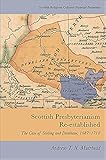Scottish Presbyterianism Re-established : The Case of Stirling and Dunblane, 1687-1710 / Andrew Muirhead.
Material type: TextSeries: Scottish Religious Cultures : SRCPublisher: Edinburgh : Edinburgh University Press, [2022]Copyright date: ©2021Description: 1 online resource (280 p.) : 13 B/W tablesContent type:
TextSeries: Scottish Religious Cultures : SRCPublisher: Edinburgh : Edinburgh University Press, [2022]Copyright date: ©2021Description: 1 online resource (280 p.) : 13 B/W tablesContent type: - 9781474447409
- 285/.2411 23
- online - DeGruyter
| Item type | Current library | Call number | URL | Status | Notes | Barcode | |
|---|---|---|---|---|---|---|---|
 eBook
eBook
|
Biblioteca "Angelicum" Pont. Univ. S.Tommaso d'Aquino Nuvola online | online - DeGruyter (Browse shelf(Opens below)) | Online access | Not for loan (Accesso limitato) | Accesso per gli utenti autorizzati / Access for authorized users | (dgr)9781474447409 |
Frontmatter -- Contents -- Tables -- Acknowledgements -- Detail from Ecclesiastical Map of Scotland -- Introduction: Post-Revolution Presbyterianism in Central Scotland -- 1 Scotland and its National Church in 1688 -- 2 Ministering in the Presbyteries: Exiles and Antediluvians -- 3 Ensuring the Continuity of Ministry -- 4 The Courts of the Church and the Business of Pres -- 5 The Eldership and the Heritors -- 6 Celebrating the Sacraments -- 7 Preaching the Word, Week by Week -- 8 The Survival of Episcopacy -- 9 Church Discipline and the Law -- 10 Dunblane’s Highland Parishes -- 11 The Church and the Union of Parliaments -- Conclusion: The New Ecclesiastical Regime -- Appendices -- Bibliography -- Index
restricted access online access with authorization star
http://purl.org/coar/access_right/c_16ec
Presbyterianism and the governance of the Church of Scotland at the turn of the eighteenth centuryExamines church and civil records available in Stirling Archives and the National Records of Scotland, as well as memoirs, letters and diariesDescribes the new Presbyterian regime and the circumstances of its replacement of Episcopal ruleProvides statistical analysis of the recruitment and experiences of new ministers, their relatiships with each other and heritorsConsiders the survival of support for the episcopal regime locallyGives an in-depth examination of local responses to the controversy leading up to the Act of UnionIn 1690, the Church of Scotland rejected episcopal authority and settled as Presbyterian. The adjacent Presbyteries of Stirling and Dunblane covered an area that included both lowland and highland communities, speaking both English and Gaelic and supporting both the new government and the old – thus forming a representative picture of the nation as a whole. This book examines the ways in which the two Presbyteries operated administratively, theologically and geographically under the new regime. By surveying and analysing surviving church records from 1687 to 1710 at Presbytery and parish level, Andrew T. N. Muirhead shows how the two Presbyteries related to civil authorities, how they dealt with problematic discipline cases referred by the Kirk Sessions, their involvement in the Union negotiations and their overall functioning as human, as well as religious, institution in seventeenth-century Scotland. The resulting study advances our understanding of the profound impact that Presbyteries had on those involved with them in any capacity.
Mode of access: Internet via World Wide Web.
In English.
Description based on online resource; title from PDF title page (publisher's Web site, viewed 01. Dez 2022)


